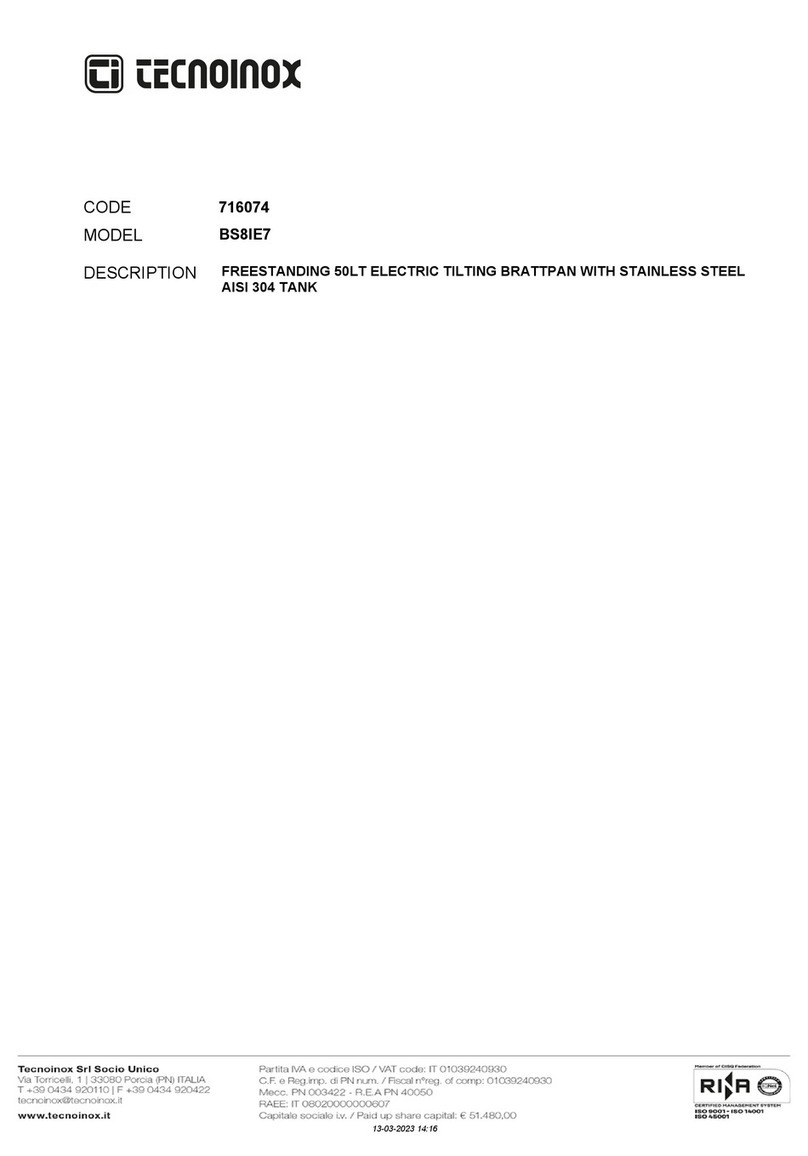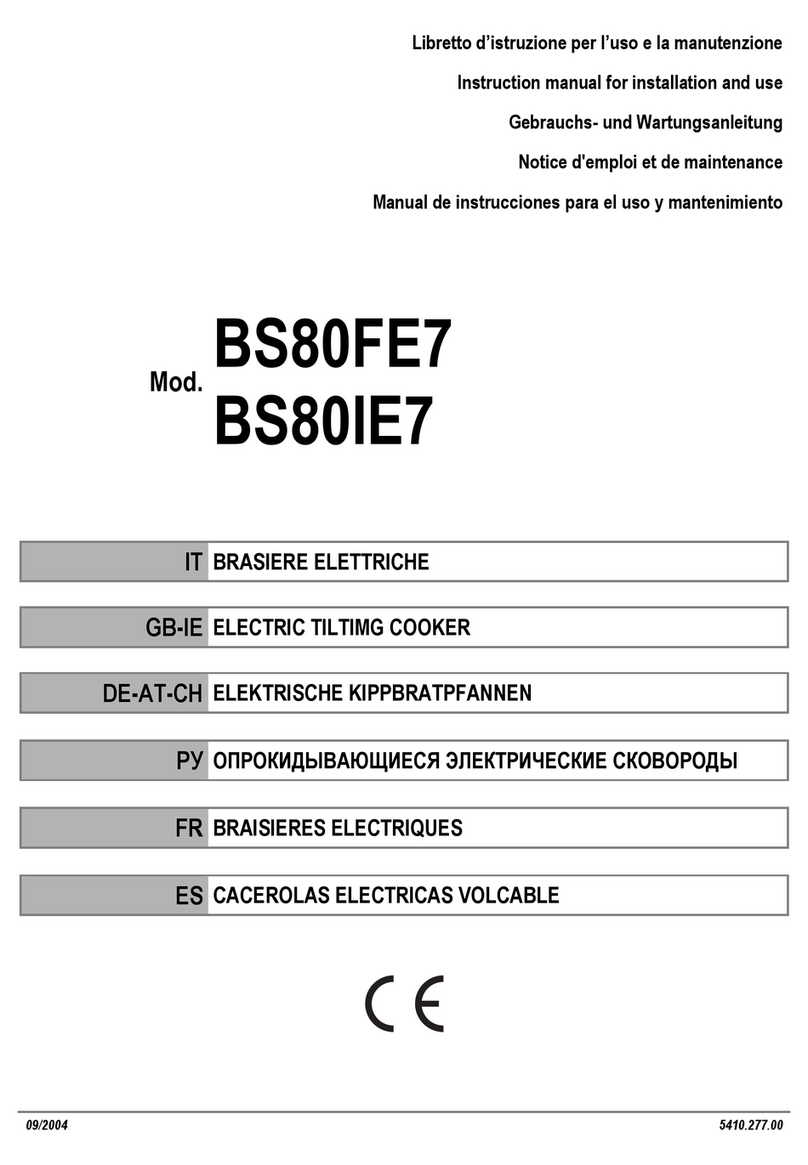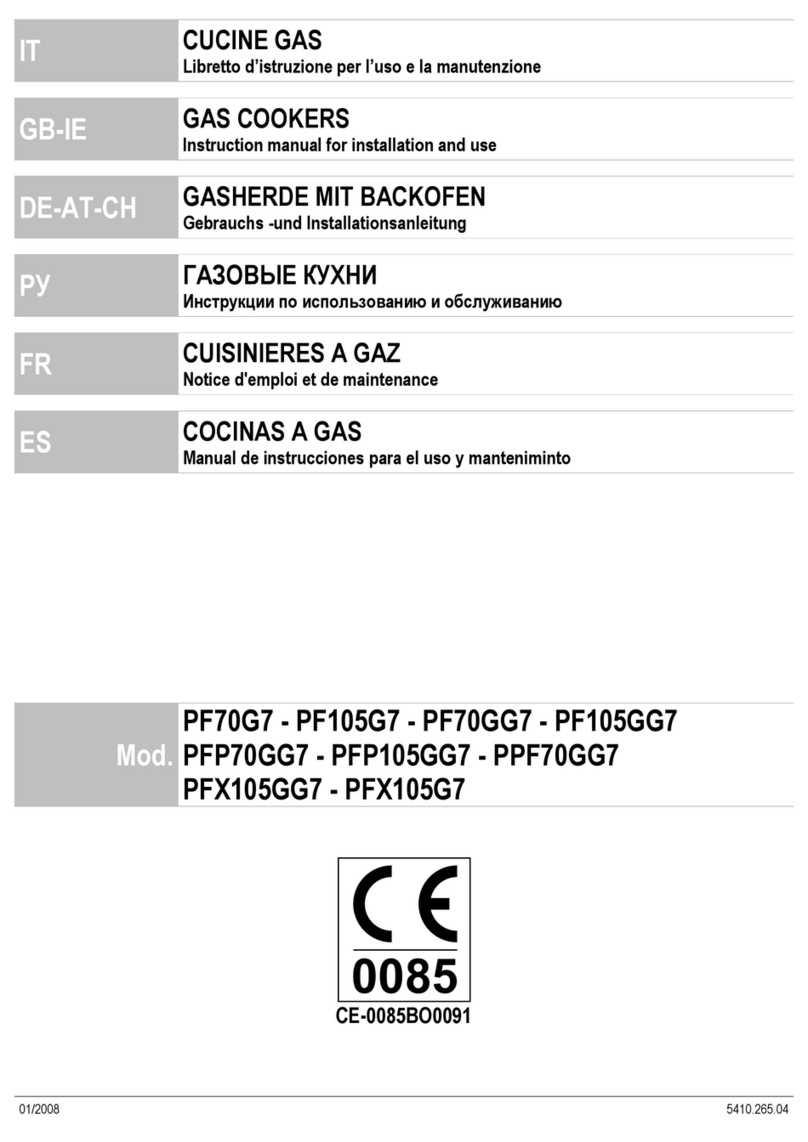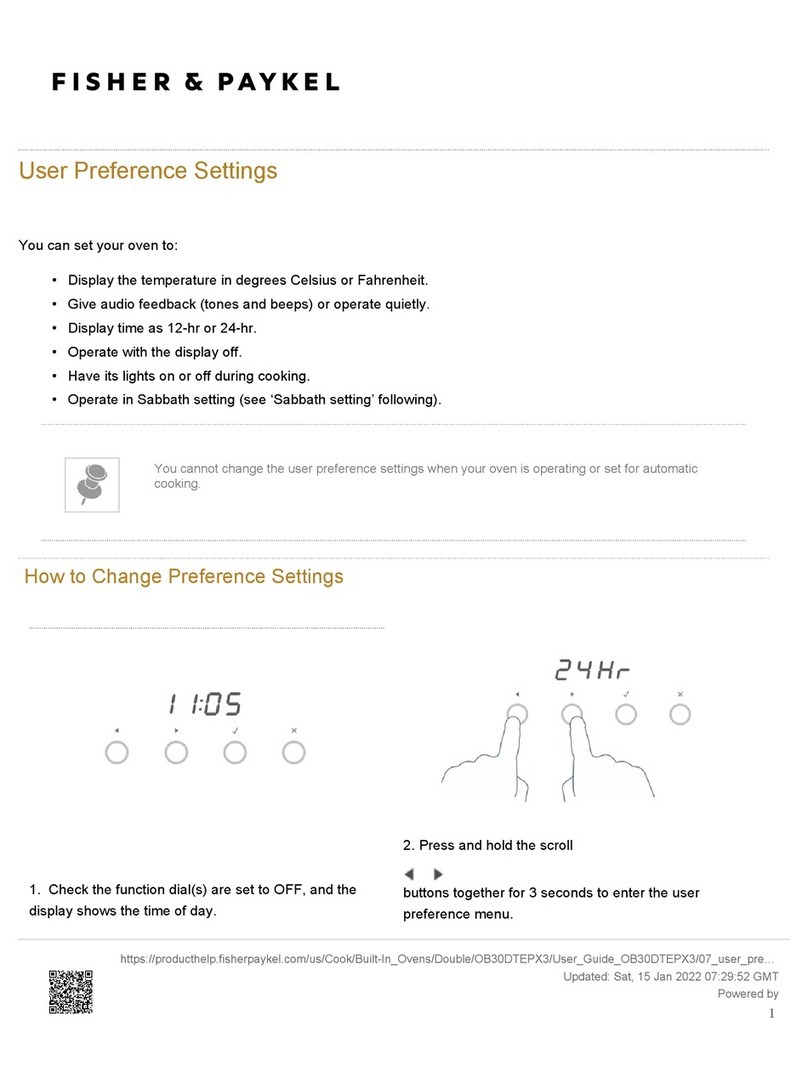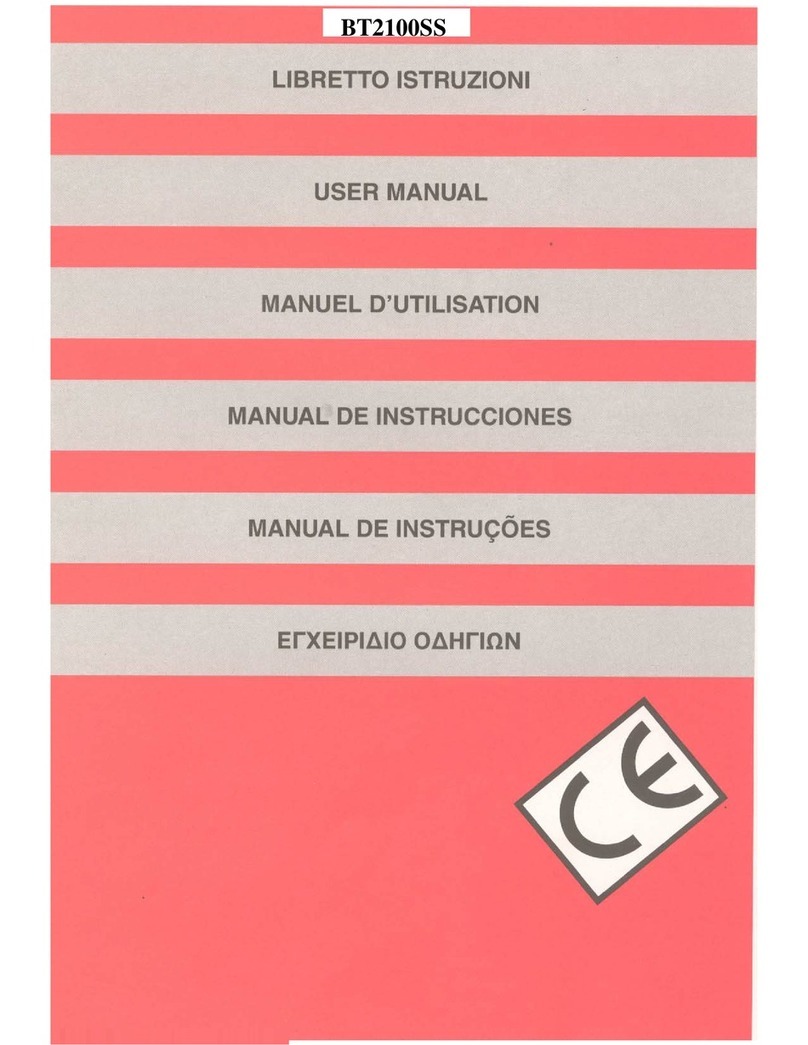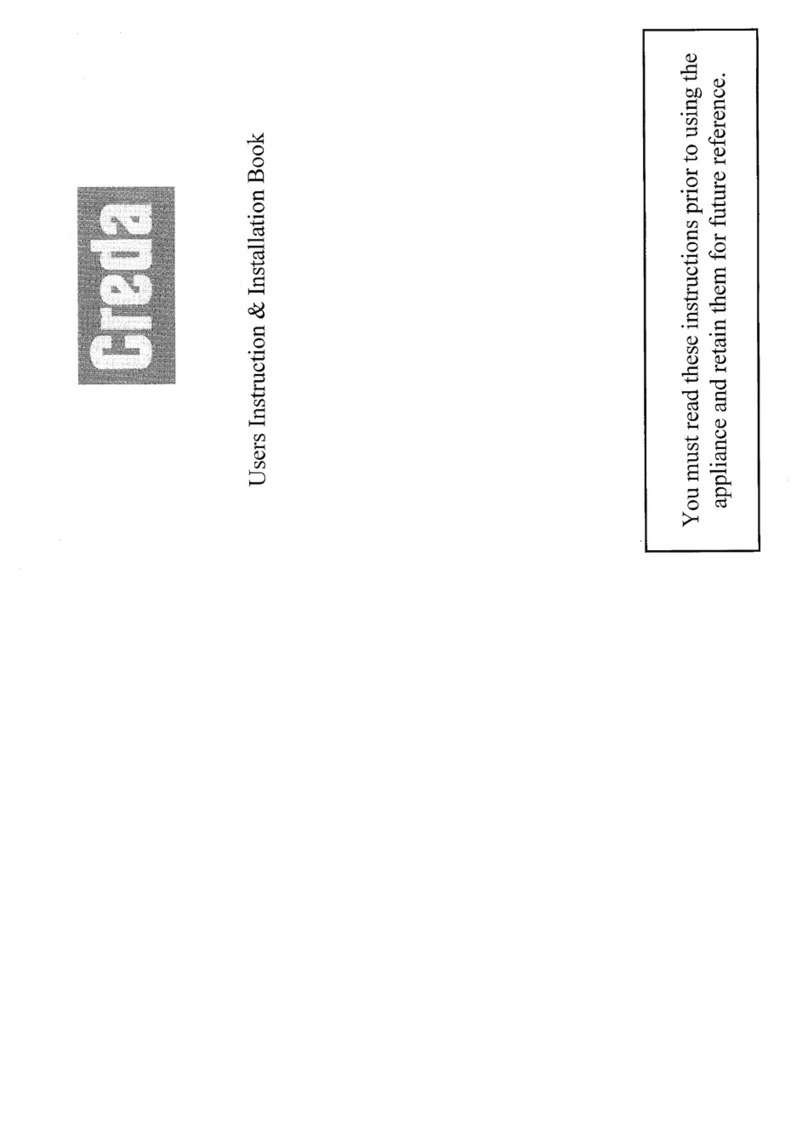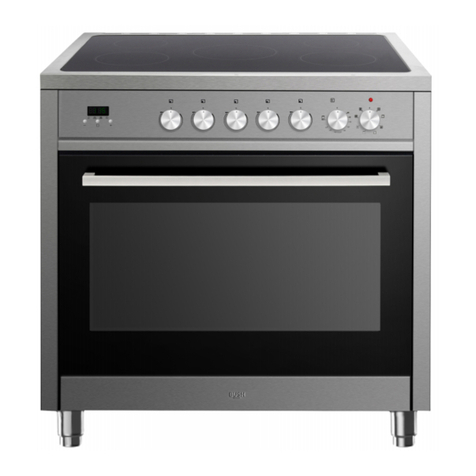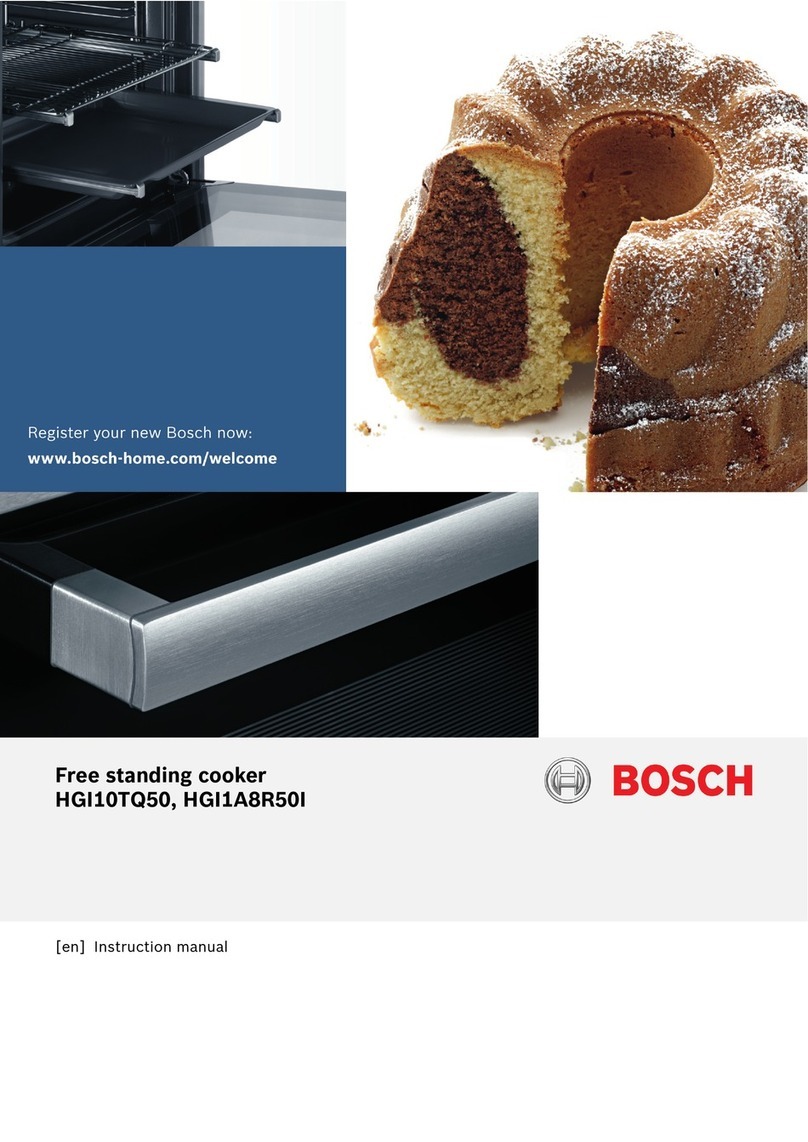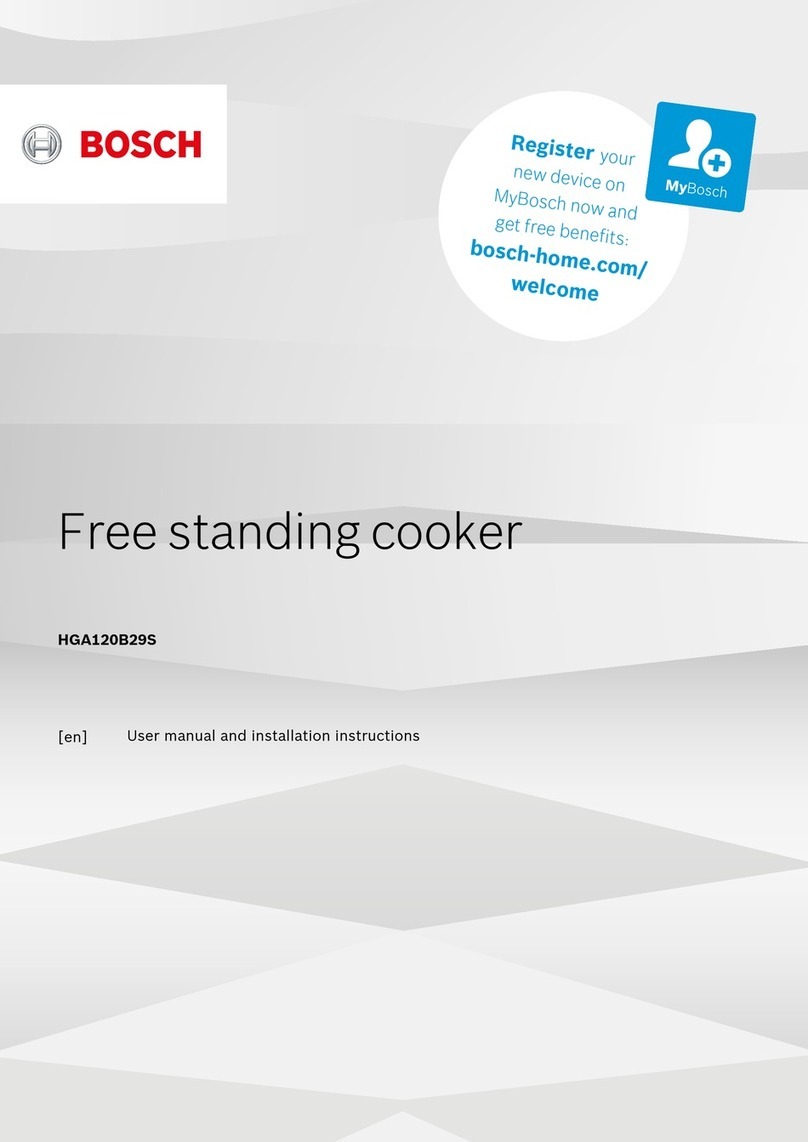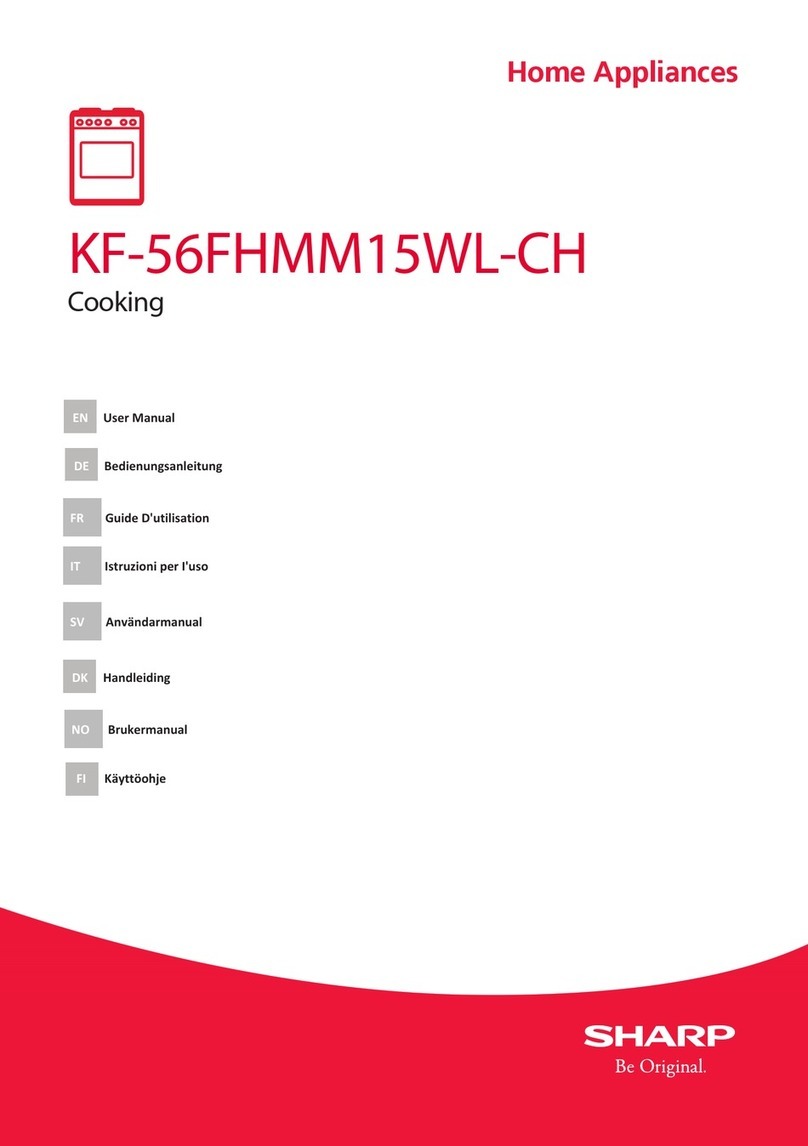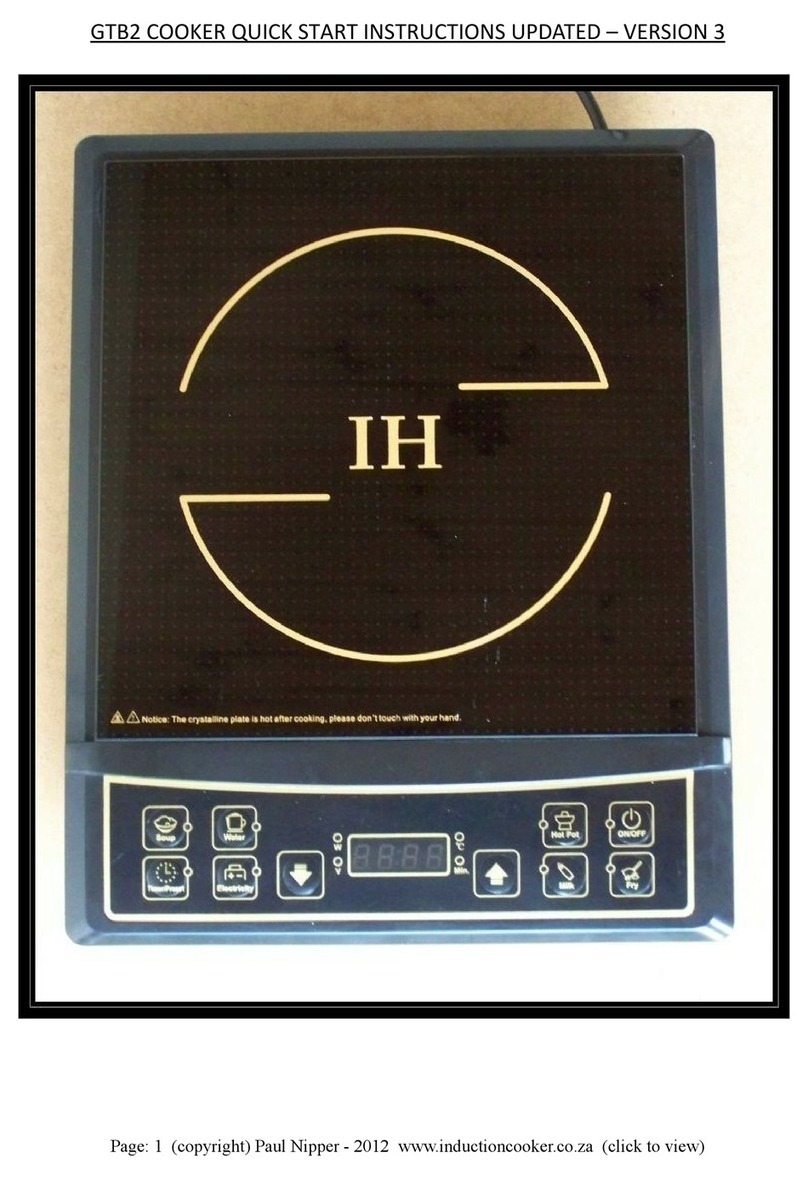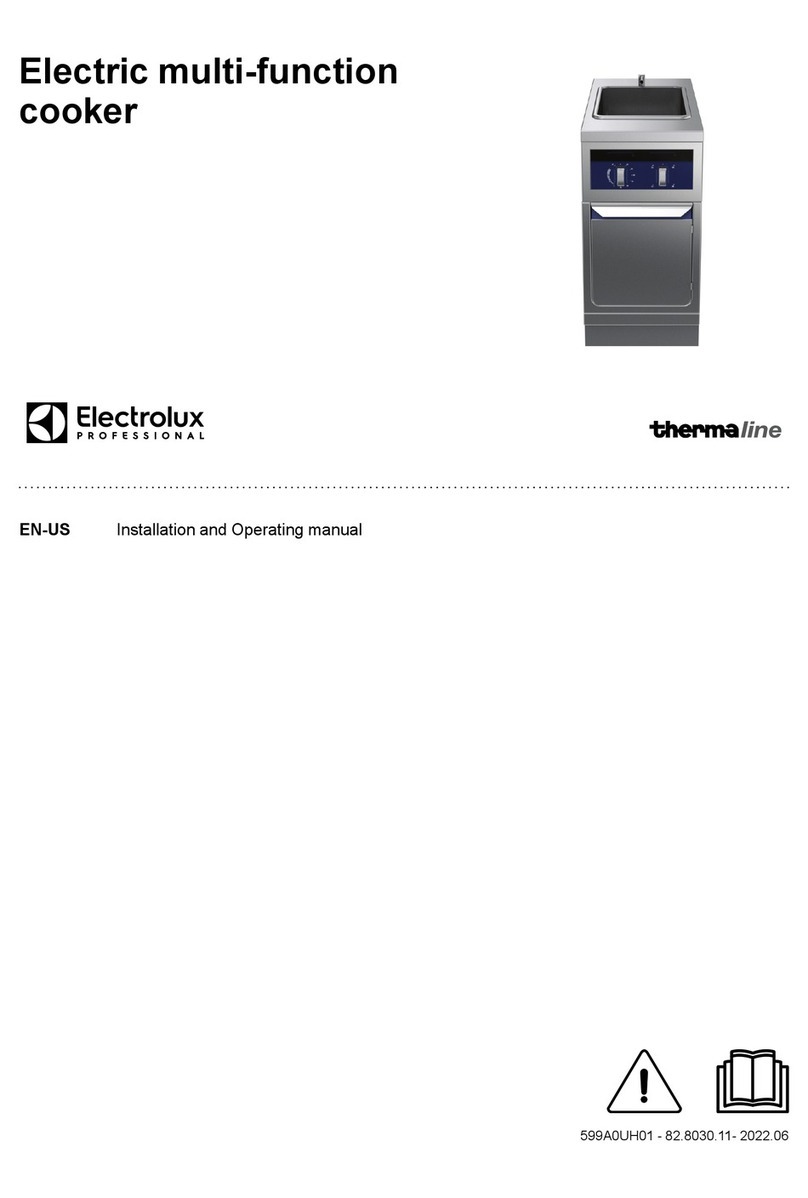Tecnoinox 316037 User manual

IT - 1
Parte 1 Installazione
CUCINE CON FORNO ELETTRICO
Avvertenze generali
L’apparecchio, al quale si riferisce il presente libretto d’istruzione, è
costruito nel rispetto dei requisiti delle Direttive: ”Bassa Tensione” e
“Compatibilità elettromagnetica”.
L’installazione deve essere eseguita a cura di personale qualificato,
secondo le norme e le prescrizioni vigenti nel paese ed in conformità
alle presenti istruzioni.
Quest’apparecchiatura è concepita unicamente per la cottura degli
alimenti.
Toglierel’imballodall’apparecchio,rimuoverelapellicolaprotettiva,se
necessario, eliminare le tracce di colla con l’ausilio di un solvente
idoneo. Si raccomanda di smaltire l’imballo secondo le prescrizioni
vigenti. Durante l’installazione é indispensabile osservare e rispettare
le seguenti norme:
Norme di Legge vigenti in materia;
Norme regionali e/o locali quali regolamento edilizio;
Prescrizioni e norme dell’azienda erogatrice dell’energia elettrica;
Norme antinfortunistiche vigenti;
Prescrizioni antincendio;
Relative Norme CEI.
Per un corretto uso rispettare sempre le seguenti avvertenze:
L'apparecchio dev’essere utilizzato esclusivamente sotto
sorveglianza.
Destinato ad uso professionale può essere utilizzato solo da
personale qualificato.
Prestare attenzione durante il funzionamento perché le piastre e
le superfici di cottura sono molto calde.
Si consiglia di installare l’apparecchio sotto ad una cappa
aspiranteperpermetterel’evacuazionedeivapori prodotti durante
la cottura.
Se l’apparecchio è installato in batteria:
Rispettare la distanza minima di 80mm tra apparecchiatura ed
eventuali pareti in materiale infiammabile, divisori, mobili da
cucina o apparecchiature adiacenti.
Le superfici a contatto con l’apparecchiatura dovranno essere
rivestite in materiale isolante termico di tipo non combustibile.
L’apparecchiatura, e in particolar modo il cavo d’alimentazione,
non deve essere sistemata vicino a fonti di calore.
L’ambiente circostante e l’apparecchiatura non devono superare
la temperatura di 50°C.
Disattivare l’apparecchiatura in caso di guasto o malfunzionamento.
Collegamento elettrico
Prima di procedere al collegamento rilevare i dati tecnici necessari di
all’installazione: tensione,frequenza,n°fasiepotenza,sullatarghetta
caratteristiche dell’apparecchiatura.
La targhetta matricola (in poliestere autoadesivo) si
trova dietro al pannello “T” fig.1.
L’installatore deve provvedere al collegamento previa interposizione
di un interruttore principale, facilmente accessibile che deve
interrompere l’erogazione d’energia in modo onnipolare.
I contatti in apertura devono avere tra loro una distanza minima di
almeno 3mm per polo.
IL CAVO:
Non deve essere posizionato vicino a fonti di calore e l’ambiente
circostante non deve superare la temperatura di 50°C
Deve essere protetto da un tubo metallico o di plastica rigida.
Dovrà avere caratteristiche non inferiori a H07 RN-F.
Dovrà avere una sezione minima come specificato in tabella
(pag.III).
Per accedere alla morsettiera “M” fig.1 rimuovere il pannello nello
schienale. Seguendo le indicazioni sullo schema elettrico, collegare i
conduttori del cavo d’alimentazione alla morsettiera.
È indispensabile collegare l’apparecchiatura ad un’efficace presa di
terra e a tale scopo in prossimità della morsettiera d’allacciamento, vi
è una vite con il simbolo al quale va allacciato il conduttore di terra.
Tenere il cavo d’alimentazione in appoggio sul fondo bloccandolo con
l’apposito pressacavo “AL” fig.1.
L’apparecchiatura deve inoltre essere inclusa in un sistema
equipotenziale, tale collegamento viene effettuato mediante una vite
contrassegnata dal simbolo posta sul retro dell’apparecchio.
Il filo equipotenziale deve avere una sezione di 10mm2.

IT - 2
Parte 2 Uso
Avvertenze generali
Si raccomanda che tutti i lavori relativi all’allacciamento, all’installazione ed alla manutenzione dell’apparecchio siano eseguiti
esclusivamente da personale qualificato ed in osservanza di tutte le relative prescrizioni!
Si consiglia di usare pentole con fondo piatto e di inserire la piastra solo dopo aver sistemato la pentola: evitare di versare liquidi freddi sulla piastra
calda. Accensione delle piastre elettriche
Attivare l’interruttore posto a monte dell’apparecchiatura.
Ruotare la manopola “A” fig.1 corrispondente alla piastra desiderata,
facendo collimare l’indice del cruscotto con la posizione scelta; si
accenderà la spia verde “B” fig.1.
La massima potenza corrisponde alla posizione “6” e la minima alla
posizione “1”.
All’avvio è consigliabile posizionare la manopola sul “6”; raggiunto il
valore massimo di cottura, ruotare la manopola su una posizione
inferiore. Le piastre sono munite di limitatore di temperatura che
intercetta l’alimentazione elettrica quando questa raggiunge 450°C, il
limitatore si riattiva automaticamente.
Spegnimento delle piastre elettriche
Posizionare la manopola sulla posizione di spegnimento “0”. Disinserire l’interruttore elettrico installato a monte
dell’apparecchiatura.
Accensione del forno elettrico
Il sistema di funzionamento delle resistenze è controllato da un
selettorea4posizioni,mentrelatemperaturaall’interno dellacamera
è controllata da un termostato (60-300°C).
Il selettore consente di scegliere il tipo di riscaldamento più idoneo
inserendo in modo appropriato gli elementi riscaldanti.
Ruotarelamanopola“C”fig.1selettoredicomandoresistenzesuuna
delle posizioni d’utilizzo. L’accensione della lampada spia verde “E”
fig.1 indica che la macchina è sotto tensione.
Ruotare la manopola “D” fig.1 termostato fino alla gradazione
corrispondente la temperatura di cottura desiderata. L’accensione
della spia arancione “F” fig.1 segnala che le resistenze sono inserite.
Posizioni manopola C
0 Posizione di spento
Elementi riscaldanti inferiore e superiore
Elemento riscaldante superiore ”Grill”
Elemento riscaldante inferiore
Posizioni manopola D
C°
0 60 120 150 180 210 240 270 300
Tutte le cotture devono essere effettuate con la porta del
forno chiusa.
Spegnimento del forno elettrico
Riportare le manopole “C” e “D” fig.1 sulla posizione “0”. Disinserire l’interruttore elettrico installato a monte
dell’apparecchiatura.
Termostato di sicurezza
L’apparecchiatura è dotata di un termostato di sicurezza che
interviene interrompendo l’alimentazione elettrica in caso di
funzionamento anomalo o surriscaldamento
Per ripristinare il funzionamento dell’apparecchio rimuovere il
cruscotto estraendo le viti poste nella parte inferiore dello stesso,
premere infine il pulsante “G” fig.1. Questa operazione deve essere
eseguita da un tecnico specializzato.

IT - 3
Parte 3 Pulizia e cura
Pulizia generale
La pulizia deve essere effettuata solamente ad apparecchio raffreddato e disinserito elettricamente.
Si ricorda, che la pulizia èmolto importante per il buon funzionamento
e per una lunga durata dell’apparecchio.
Le parti amovibili sono da lavare separatamente con acqua calda e
detergente e da sciacquare poi con acqua corrente. Per macchie
molto resistenti usare acqua calda e aceto.
Per la pulizia delle parti d’acciaio inossidabile non sono da impiegare
sostanze aggressive o comunque detergenti abrasivi. L’uso di
paglietta di ferro è sconsigliato poiché può provocare formazione di
ruggine. Per lo stesso motivo evitare il contatto con materiali ferrosi,
stracci pesanti o ruvidi, o con lana d'acciaio.
Evitare inoltre anche l’utilizzo di carta o tela vetrata; in sostituzione e
solopercasiparticolarisipuòusarepietrapomiceinpolvere;nelcaso
di sporco tenace si consiglia l’ausilio di spugne (Scotch Brite).
Pulizia del forno
Fare attenzione durante la pulizia del forno a non danneggiare il
sensore “K” del termostato posto al suo interno.
Porte e fianchi devono essere puliti solo a macchina completamente
raffreddata. Per le parti smaltate, si consiglia di utilizzare
semplicemente acqua calda e detergenti non abrasivi o acidi.
In caso di sporco tenace, si può utilizzare dello spray per forni e grill
facilmente reperibili in commercio. In questo caso osservare
attentamente le avvertenze del produttore.
Comportamento in caso di prolungata inattività
Disinserire l’alimentazione elettrica. Pulire accuratamente l’apparecchio seguendo le istruzioni e asciugarlo con cura.
Comportamento in caso di guasti
Non improvvisarsi manutentori, la manomissione
dell'apparecchio da parte di personale non
qualificato implica il decadimento della garanzia.
I guasti non sempre dipendono dalla qualità dei componenti, che nel
nostro caso sono d’ottima fattura, essi possono essere causati anche
dasbalzidi tensione, da polvereosporco che penetra neicomponenti
funzionali.
In qualsiasi caso in cui si sospetta un funzionamento anormale
STACCARE SEMPRE l'alimentazione elettrica ed avvisare il servizio
d’assistenza autorizzato.
Manutenzione
L'apparecchiatura non necessita di particolare manutenzione oltre alla normale pulizia; si consiglia comunque un controllo annuale effettuato dal
centro d’assistenza e a tale scopo si raccomanda la stipula di un contratto di manutenzione.
Ecologia e ambiente
Le nostre apparecchiature sono studiate ed ottimizzate, con test di
laboratorio, al fine di ottenere prestazioni e rendimenti elevati. In ogni
caso, al fine di contenere i consumi energetici (elettricità, gas ed
acqua), si consiglia di evitare l’utilizzo dell’apparecchiatura per lungo
tempo a vuoto o in condizioni che compromettano il rendimento
ottimale.
Tutti i materiali utilizzati per l’imballo sono compatibili con l’ambiente.
Essi possono essere conservati senza pericolo o bruciati in un
apposito impianto di combustione per rifiuti. I componenti in materiale
plastico soggetti ad eventuale smaltimento con riciclaggio sono:
Polietilene: pellicola esterna dell’imballo e/o pluribol
Polipropilene: reggette
Polistirolo espanso: angolari, lastre e cubi di protezione
Alla fine del ciclo di vita del prodotto evitare che l’apparecchiatura sia
dispersa nell’ambiente.
Le nostre apparecchiature sono realizzate con materiali metallici
(acciaio inox, ferro, lamiera alluminata, ecc.) in percentuale superiore al
90% ed è quindi possibile un riciclaggio degli stessi, per mezzo delle
strutture tradizionali di recupero, nel rispetto delle normative vigenti nel
proprio paese.
Rendere inutilizzabile l’apparecchiatura per lo
smaltimento rimuovendo il cavo d’alimentazione e
qualsiasi eventuale dispositivo di chiusura dei vani
o cavità, per evitare che qualcuno possa rimanere
chiuso al loro interno.
Il costruttore declina ogni responsabilità nel caso di
danni provocati da errata installazione, impropria
manutenzione ed inosservanza delle prescrizioni di
sicurezza!
K

GB / IE - 1 5410.310.00
Part 1 Installation
ELECTRIC COOKERS WITH ELECTRIC OVEN
General Instructions
The appliance referred to in this manual has been manufactured in
conformity to the following Directives: “Low Voltage” &
“Electromagnetic Compatibility.
The appliance must be installed by a qualified technician according to
the regulations and directives in force in the country where it is
installed, as well as the instructions in this manual.
This appliance has been designed exclusively for cooking food.
Remove the packaging from the appliance as well as the protective
plastic sheet, and, if necessary, remove traces of glue with a suitable
solvent. To dispose of the packaging, follow local directives.
When installing the appliance, the following regulations must be
observed:
Applicable national laws in force;
Regional and/or local regulations, such as building codes;
Directives and regulations of the local electricity board;
Accident prevention regulations in force;
Fire prevention regulations;
To use the appliance correctly follow the warnings below:
Theappliancemustneverbeleftunattendedwhenitisbeingused!
The appliance is designed for professional use and therefore
should only be used by qualified personnel.
Care must be taken when using the appliance because the
cooking surfaces are very hot.
The appliance should be installed under an extractor hood for
evacuating the cooking fumes.
If the appliance is installed in line:
Respectaminimum distance of 80mmbetweentheappliance and
any walls made of flammable material, partitions, kitchen furniture
or nearby equipment.
The surfaces in contact with the appliance must be covered with
non-combustible heat insulating material.
Theappliance,andespeciallythecable,mustnotbeinstallednear
heat sources.
The temperature of the environment in which the appliance is
installed must not exceed 50°C.
Switch the appliance off in the case of failure or malfunction.
Connection to the mains
Before connecting the appliance note the specifications necessary for
the installation: voltage, frequency, number of phases and power on
the data plate of the appliance.
The self adhesive polyester data plate is behind the
panel “T” pic.1.
The installer must make the connection after having installed a main
switch, which is easy to reach and disconnects every pole supplying
electrical power to the appliance.
The switch supplying electrical energy to the appliance must have a
minimum distance of at least 3mm between the poles when the
contacts are open.
THE CABLE:
Must not be installed near heat sources, the temperature
surrounding the appliance must not exceed 50°C.
Must be protected by a metal or a plastic tube
Must at least meet H07 RN-F standards.
Must have the minimum section indicated in the table (page III).
To reach terminal board “M” pic .2, remove the rear panel. Following
the indications in the wiring diagram, connect the wires of the power
cable to the terminal board.
The appliance must be connected to a good earth. There is a screw
marked with the symbol near the terminal board where the earth
conductor should be connected.
Hold the power cable in place on the bottom, blocking it in place with
the relevant cable clamp “AL” pic.1.
Theappliancemust also beconnected to anequipotentialearth. Such
connection takes place by a screw marked as placed on the back
of the appliance.
The equipotential wire must have a section of 10mm2.

GB / IE - 2
Part 2 Use
General Instructions
Connection to the mains, installation, and maintenance of the appliance must only be carried out by qualified technicians only,
in observance of all applicable regulations!
We recommend using pots with flat bottoms. Turn the hot plate on
after placing the pan on it. Avoid spilling cold liquids on the hot plate.
Turning the hot plates on
Switch the power on using the switch upstream of the appliance.
Turnknob“A”pic.1of the desired plate, until it fits with the index ofthe
panel in the chosen position; the relevant green luminous indicator
green “B” pic.1 will light.
The maximum power corresponds to position “6”; the minimum one
corresponds to position “1”.
When you turn the appliance on, first turn the knob to position “6”;
when the maximum temperature for cooking is reached, turn the
knob to a lower position. The hot plates feature a temperature limiter
that cuts off the electric supply: when the temperature reaches
450°C, the limiter reactivates automatically.
Turning the hot plates off
Turn the knob to “0”. Switch the power off using the switch upstream of the appliance.
Turning the electric oven on
The heating elements are controlled by a 4 position selector switch,
while the temperature inside the chamber is controlled by a
thermostat (60-300°C).
The selector lets you choose the most suitable type of heating using
the appropriate heating elements.
Turn the knob “C” pic.1 of the heating elements' selector to one of
the on positions. When the green indicator “E” pic.1 lights, the oven
is supplied with power.
Turn the knob "D" pic.1 of the thermostat until you reach the desired
cooking temperature. The orange luminous indicator “F” pic.1 lights
indicating that the heating elements are on.
Positions of knob C
0 Off
Top and bottom heating elements
Top heating element “Grill”
Bottom heating element
Positions of knob D
°C 0 60 120 150 180 210 240 270 300
All the cooking must be done with the oven door closed.
Turning the electric oven off
Turn knobs “C” and “D” pic.1 to “0”. Disconnect the switch upstream of the appliance.
Safety Thermostat
The appliance is equipped with a safety thermostat that cuts off the
electric power supply in case of anomalies or overheating. To turn the appliance on again, remove the control panel unscrewing
the screws at its bottom; then press button “G” pic.1. This operation
must be carried out by a specialised technician.

GB / IE - 3
Part 3 Cleaning and care of the appliance
Cleaning
The appliance must be cold and the electrical power
turned off to clean it.
Keeping the appliance clean is very important for a long and trouble-
free working life. The removable parts should be washed separately
with warm water and detergent, then rinsed in running water. For
stubborn deposits use hot water and vinegar.
Do not use harsh or abrasive detergents to clean the stainless steel
parts. Iron cleaning pads should not be used as they cause the
formation of rust. For the same reason, avoid contact with ferrous
materials.While cleaning, avoidusingabrasive paperorcloth; instead
and only in special cases you can use pumice stone powder; we
recommend using sponges (eg. Scotch Brite) to remove stubborn
deposits.
Cleaning the oven
While you are cleaning the oven, be careful not to damage the
thermostat sensor “K” inside the chamber.
Clean the door and the sides of the oven when it is cold. To clean
enamelled parts, we recommend you to use hot water and non-
abrasive or acid detergents. You can also use common sprays for
cleaning ovens and grills to remove stubborn deposits. If spray
products are used, follow the manufacturer’s instructions.
What to do if the unit is not going to be used for a long time
Turn the electrical power off. Clean the unit thoroughly following the instructions and dry it carefully.
Malfunctions
Unauthorised persons should never attempt to repair
the appliance, or carry out maintenance. Tampering
with the appliance voids the warranty!
Malfunctions do not always depend on the quality of the components
used. These appliances are manufactured using top quality
components.
Failures may be caused by voltage surges, or dust and dirt filtering in
the operating components.
In any case, if anomalies are noticed or suspected, ALWAYS turn
the appliance off and disconnect it from the mains. Call the
authorised repair service.
Maintenance
The appliance needs no specific maintenance besides normal cleaning; we do however suggest having it checked once a year by the assistance
centre: that’s why we recommend drawing up a maintenance contract.
Ecology and environment
Our appliances are studied and optimised, with lab tests, to provide
high performance and yields. However, in order to reduce energy
consumption (electricity, gas and water), we suggest not using the
appliance for any length of time if it is empty or under conditions that
compromise optimum yield.
All packaging materials are environment-friendly. They can be kept
without creating problems or burnt in a waste incinerator plant. The
following plastic components can be recycled:
Polyethylene: external packaging material and/or pluribol film
Polypropylene: straps
Polystyrene foam: corner pieces, sheets and protection blocks
At the end of the appliance’s useful life, dispose of it properly.
90% of each appliance is made of metal (stainless steel, iron,
aluminated sheet, etc.) hence it can be recycled by the relative
recycling organisations in compliance with the standards in force in
your country.
Prepare the appliance for disposal, so it cannot be
used any more, by removing the power cable and
any locks to prevent anyone getting locked inside
accidentally.
The Manufacturer declines any responsibility for
damage caused by improper or incorrect installation
or maintenance of the appliance, or failure to
observe safety regulations!
K

DE / AT / CH - 1
Teil 1 Installation
ELEKTRO-HERDE MIT ELEKTRO-BACKOFEN
Allgemeine Anmerkungen
Das in dieser Gebrauchsanweisung beschriebene Gerät ist gemäß
folgenden Vorschriften gebaut: “Niederspannung”;
“Elektromagnetische Kompatibilität”.
DieInstallation muss vonkompetentem Personal laut derVorschriften
und Gesetze des Landes sowie in Übereinstimmung mit dieser
Gebrauchsanweisung durchgeführt werden.
Dieses Gerät ist ausschließlich für das Kochen von Speisen gedacht.
Die Verpackung des Geräts entfernen, die Schutzfolie abnehmen und
eventuelle Klebstoffrückstände mit einem geeigneten Lösungsmittel
entfernen.
Das Verpackungsmaterial muss vorschriftsmäßig entsorgt werden.
Während der Installation sind alle geltenden Vorschriften zu
berücksichtigen:
Vorschrift der gültigen Gesetze der Materie;
Regionale und/oder lokale Bauvorschriften;
Vorschriften und Regeln des Stromwerkes;
Geltende Unfallverhütungsgesetze;
Brandschutzvorschriften;
Für einen korrekten Gebrauch folgende Hinweise beachten:
Das Gerät nur unter Aufsicht betreiben!
Das Gerät ist für gewerbliche Zwecke gebaut und darf nur von
Fachpersonal betrieben werden.
Es ist darauf zu achten, dass sich die Kochplatten und
Geräteoberflächen während des Betriebs erhitzen.
Es wird empfohlen, das Gerät unter einer Abzughaube
aufzustellen, um die während des Garens erzeugten Dämpfe
abzuleiten.
Bei der Aufstellung neben anderen Geräten:
Zwischen dem Gerät und eventuellen Wänden aus brennbarem
Material, Trennwänden, Küchenmöbeln oder nebenstehenden
Geräten mindestens 80mm. Abstand halten. Die Kontaktflächen
müssen mit nicht brennbarem Wärmeisoliermaterial verkleidet
werden.
Das Gerät darf nicht in der Nähe von Wärmequellen aufgestellt
werden und die Raumtemperatur muss stets unter 50°C liegen.
Im Schadensfall oder bei mangelhaftem Betrieb das Gerät ausschalten
Netzanschluss
Vor dem Anschluss sind die am Typenschild vorgegebenen Daten zu
prüfen: Spannung, Frequenz, Phasenanzahl und Leistung.
Das Typenschild (aus selbsthaftendem Polyester) befindet
sich hinter der Bedienblende “T“ Abb.2.
Der Installateur muss beim Anschluss einen leicht zugänglichen
Hauptschalter zwischenschalten, der die Stromzufuhr allpolig
unterbricht.
Die mindeste Kontaktöffnungsweite muss pro Pol 3mm betragen.
DAS VERSORSUNGSKABEL:
Das darf nicht in der Nähe von Hitzequellen verlegt werden und
die Raumtemperatur darf nicht über 50°C liegen.
Es muss in einem Metallrohr oder in einem steifen Kunststoffrohr
verlegt werden.
Es muss mindestens dem Typ H07 RN-F entsprechen.
Es muss einen Mindestquerschnitt gemäß der Tabelle aufweisen
(Seite III).
UmandasKlemmenbrett“M”Abb.1zugelangen,istdieBedienblende
durch Ausschrauben der am unteren Teil der Blende selbst
befindlichen Befestigungsschrauben zu entfernen. Unter Befolgung
der Anweisungen des elektrischen Schaltplans die Leiter des
Netzkabels an die Klemmleiste anschließen.
Das Gerät muss unbedingt geerdet werden.
Zu diesem Zweck befindet sich in der Nähe des
Anschlussklemmenbretts eine durch das Symbol gekennzeichnete
Erdungsklemme, an der das Erdungskabel befestigt werden muss.
Das Kabel immer dem Boden entlang führen, indem es mit der
Kabelklemme “AL” Abb.1 fixiert wird.
Das Gerät ist ferner in ein Potentialausgleichssystem einzubeziehen.
Der Anschluss erfolgt über die mit dem Symbol gekennzeichnete
Schraube, die sich an der Geräterückwand befindet.
Der Potentialleiter muss einen Mindestquerschnitt von 10mm2
aufweisen.

DE / AT / CH - 2
Teil 2 Gebrauch
Allgemeine Anmerkungen
Alle Maßnahmen bezüglich elektrischem Anschluss, Installation sowie Wartung des Gerätes dürfen nur von qualifiziertem
Personal unter Beachtung aller entsprechenden Vorschriften durchgeführt werden!
Es wird empfohlen, Kochtöpfe mit flachem Boden anzuwenden sowie die Platte erst nachdem der Kochtopf aufgestellt wurde in Betrieb zu nehmen.
Außerdem keine kalten Flüssigkeiten auf die heiße Platte gießen.
Einschalten der Kochplatten
Den Hauptschalter stromaufwärts des Gerätes einschalten.
Den Drehschalter “A” Abb.1 drehen, bis die gewünschte Position mit
der Markierung an der Bedienblende übereinstimmt; die grüne
Kontrollleuchte “B” Abb.1 schaltet sich ein.
Die maximale Leistung entspricht der Position “6“, die minimale
hingegen der Position “1”.
Anfangs ist es empfehlenswert, den Drehschalter auf Position “6” zu
stellen; bei Erreichen der maximalen Temperatur kann der
Drehschalter auf eine untere Stufe gestellt werden.
Die Platten sind mit einem Temperaturstopp ausgestattet, der die
elektrische Speisung dann unterbricht, wenn die Platten eine
Temperatur von 450°C erreichen. Der Temperaturstopp tritt
automatisch in Betrieb.
Ausschalten der Kochplatten
Den Drehschalter auf Position “0” drehen. Den Hauptschalter stromaufwärts des Gerätes ausschalten.
Einschalten des Backofens
Das Betriebssystem der Widerstände wird durch einen 4-Stufen-
Wählschalter gesteuert, während die Temperatur im Backraum
durch einen Thermostat (60-300°C) überwacht wird.
Mit dem Wählschalter kann jeweils das geeignete Heizelement
eingeschaltet werden.
Den Drehschalter “C” Abb.1 auf eine der möglichen Stellungen
drehen. Das Aufleuchten der grünen Kontrollleuchte “E” Abb.1
bedeutet, dass das Gerät unter Spannung steht.
Den Thermostat-Drehschalter “D” Abb.1 auf die gewünschte
Temperatur drehen. Das Aufleuchten der orangen Kontrollleuchte
“F” Abb.1 bedeutet, dass die Heizelemente funktionieren.
Drehschalter C
0 Aus
Ober- und Unterhitze
Oberhitze „Grill-Funktion“
Unterhitze
Drehschalter D
°C
0 60 120 150 180 210 240 270 300
Beim Backen muss dieBackofentür möglichst
geschlossen bleiben.
Ausschalten des Backofens
Die Drehschalter “C” und “D” Abb.1 auf “0” drehen. Den Hauptschalter stromaufwärts des Geräts ausschalten.
Sicherheitsthermostat
Das Gerät ist mit einem Sicherheitsthermostat ausgestattet, der bei
abnormalem Betrieb durch Unterbrechung der elektrischen Speisung
einschreitet.
Um den Gerätebetrieb wieder herzustellen, die Bedienblende durch
Ausschrauben der unteren Schrauben abnehmen und die Taste “G”
Abb.1 drücken. Diese Durchführung muss von einem spezialisierten
Techniker vorgenommen werden.

DE / AT / CH - 3
Teil 3 Reini
g
un
g
und Instandhaltun
g
Allgemeine Reinigung
Die Reinigung nur bei ausgestecktem und abgekühltem Gerät durchführen.
Der Reinigungsvorgang ist für einen einwandfreien Betrieb und eine
lange Lebensdauer des Geräts sehr wichtig.
Die abnehmbaren Teile mit warmem Wasser und Reinigungsmittel
waschen und unter fließendem Wasser nachspülen; für
hartnäckigeren Schmutz warmes Wasser und Essig verwenden.
Danach mit einem weichen und trockenen Lappen abwischen.
Zur Reinigung der Teile aus rostfreiem Stahl, keine aggressive Mittel
oder scheuernde Reinigungsmittel verwenden.
DieBenutzungvon Stahlwolle auf Edelstahlteilenistzu vermeiden, da
sich hierdurch Rost bilden könnte.
Aus demselben Grund ist der Kontakt mit eisenhältigem Material,
schweren Lappen oder Stahlwolle zu meiden.
Glaspapier oder Schmirgelpapier sollten bei der Reinigung nicht
verwendet werden; man kann in besonderen Fällen pulverförmigen
Bimssteinverwenden;beistärkererVerschmutzungempfehlenwirdie
Benutzung von Schwämmen (z.B. Schwamm der Fa. Scotch).
Reinigung der Backofen
Während der Reinigung ist darauf zu achten, dass der im Backofen
befindliche Thermostatfühler „K“ nicht beschädigt wird.
Wie auch alle anderen Reinigungsmaßnahmen, werden die
Backofentür und die seitlichen Backofenplatten nur bei ausgekühltem
Gerät gereinigt. Für die emaillierten Teile ist wie für das
Backofeninnere vorzugehen, wobei warmes Wasser und keine
scheuerndenMitteloder Säuren angewandt werden.Beihartnäckigen
Verschmutzungen kann handelsüblicher Backofen- und Grillreiniger
zur Hilfe genommen werden. Dazu sind die Hinweise des Herstellers
des Produkts zu beachten.
Verhalten bei längerem Betriebsstillstand
Die Stromzufuhr unterbrechen. Das Gerät gemäß der Reinigungshinweise reinigen und sorgfältig abtrocknen.
Verhalten im Schadensfall
Auf keinen Fall dürfen nicht befugte Personen versuchen, die Reparatur durchzuführen. Dies würde einen Verfall der Garantie
nach sich ziehen.
Nicht immer hängt ein Schaden von der Qualität der Bestandteile ab,
die in unserem Fall erstklassig ist. Schäden können durch
Stromschwankungen, Staub und/oder Schmutz, der in die
Betriebsteile eintritt, verursacht werden.
Sollte der Verdacht auf eine Betriebsstörung des Gerätes vorliegen,
IMMER die Stromversorgung unterbrechen und den befugten
Kundendienst verständigen.
Wartung
DasGerätbenötigtneben dernormalen,regelmäßigenReinigungkeine besonderenWartungsarbeiten;eswirddennocheine jährliche Kontrolledurch
eine Kundendienststelle empfohlen, weshalb der Abschluss eines Wartungsvertrages ratsam ist.
Umweltschutz
Unsere Geräte werden durch zahlreiche Laboruntersuchungen
geprüft und optimiert, um so besonders hohe Leistungen zu erzielen.
DennochwirdzurEinschränkung des Energieverbrauchs (Strom,Gas
und Wasser) empfohlen, das Gerät nicht für längere Zeit unbenutzt
eingeschaltet zu lassen und es nur unter optimalen
Betriebsbedingungen zu verwenden.
Alle als Verpackung verwendeten Materialien sind umweltverträglich.
Sie können daher ohne Gefahr aufbewahrt oder in einer dafür
vorgesehenen Müllverbrennungsanlage verbrannt werden. Die
folgenden Kunststoffteile sind für eine eventuelle Wiederverwertung
geeignet:
Polyäthylen: Außenhülle der Verpackung und/oder Noppenfolien
Polypropylen: Bänder
Polystyrolschaum: winkel- oder würfelförmiges Schutzmaterial
sowie Schutzabdeckungen
Nach Ablauf der vorgesehenen Lebensdauer des Geräts ist dieses
ordnungsgemäß zu entsorgen.
Alle unsere Geräte werden zu mehr als 90% aus Metall hergestellt
(Edelstahl, Eisen, Aluminiumblech etc.), sie können daher den
jeweiligen ortsüblichen Entsorgungsstellen problemlos zur
Wiederverwertung zugeführt werden.
Vor der Entsorgung sind die Geräte
funktionsuntüchtig zu machen, indem das Netzkabel
am Gerät abgeschnitten wird. Eventuell vorhandene
Verschlussvorrichtungen an Geräteinnenräumen
oder an der Oberseite des Gerätes entfernen, damit
sich niemand darin einschließen kann.
Der Hersteller übernimmt für Schäden aufgrund
falscher Installation, unsachgemäßer Wartung und
Nichtbeachtung der Sicherheitsvorschriftenkeine
Haftung.
K

FR - 1
1ère Partie Installation
CUISINIERES AVEC FOUR ELECTRIQUE
Conseils généraux
L’appareil auquel la présente notice d’emploi se réfère, a été fabriqué
conformément aux exigences requises par les Directives: ”Basse
Tension”; “Compatibilité électromagnétique”.
L’installation doit être effectuée par un personnel qualifié selon les
normes et les prescriptions en vigueur dans le pays et conformément
à la présente notice.
Cet appareil a été conçu pour la cuisson des aliments uniquement.
Sortir l’appareil de l’emballage, retirer le film protecteur et, si cela est
nécessaire, éliminer toute trace de colle en utilisant un solvant
approprié.
Il est recommandé d’éliminer l’emballage conformément aux
prescriptions en vigueur.
Lors de l’installation, observer et respecter toutes les normes en
vigueur, à savoir:
Dispositions légales en vigueur sur cette matière;
Normes régionales et/ou locales relatives aux normes de
construction;
Prescriptions et normes de la compagnie de l’électricité;
Normes pour la prévention des accidents en vigueur;
Prescriptions contre les incendies;
Pour utiliser correctement cet appareil, respecter les consignes
suivantes:
L’appareil ne doit être utilisé que sous surveillance!
Cet appareil n’est destiné qu’à un usage professionnel de part
d’un personnel qualifié.
Lorsqu’il fonctionne, les surfaces de l’appareil sont très chaudes:
observer les précautions nécessaires.
Il est recommandé d’installer l’appareil sous une hotte aspirante
afin d’évacuer les vapeurs qui se produisent pendant la cuisson.
S’il est installé avec d’autres appareils:
Respecterunedistance minimale de80mm entre l’appareil etles
parois réalisées en matériau inflammable, les cloisons, les
meubles de cuisine ou d’autres appareils adjacents.
Les surfaces en contact avec les éléments sus-mentionnés
devrontêtre revêtuesavecunmatériauisolantthermiquedetype
non combustible.
L'appareilet,enparticulier,lecâbled’alimentationnedoiventpas
se trouver à proximité de sources de chaleur.
Latempératureenvironnanteet celle de l’appareilne doivent pas
dépasser 50°C.
Débrancher l’appareil en cas de panne ou de mauvais fonctionnement.
Connexion électrique
Avant d’effectuer la connexion électrique, contrôler sur la plaque
signalétique les données nécessaires à l’alimentation de l’appareil:
tension, fréquence, nombre de phases et puissance.
La plaque signalétique (en polyester autoadhésif) se
trouve derrière le panneau de commande “T” fig.1.
L’installateur sera chargé d’effectuer la connexion en interposant un
interrupteur principal facilement accessible et coupant l’alimentation
électrique de manière omnipolaire.
L’ouverture minimum entre les contacts doit être d’au moins 3mm par
pôle.
LE CABLE:
ne doit pas être installé trop près d’une source de chaleur et la
température à proximité ne doit pas dépasser 50°C.
doit être protégé par un tube en métal ou en plastique rigide.
ne doit pas avoir les caractéristiques inférieures à H07 RN-F.
doit avoir une section minimale comme indiqué dans le tableau
(page III).
Pour accéder à la plaque à bornes “M” fig.1, enlever l’ arrière . Suivre
les indications du schéma électrique pour connecter les conducteurs
du câble d’alimentation au bornier.
Il est indispensable de raccorder l’appareil à une prise de terre
efficace. A cet effet, à proximité de la plaque à bornes, il y a une vis
marquée du symbole à laquelle il faudra raccorder le fil de terre.
Maintenir le câble d’alimentation collé au fond de l’appareil et le
bloquer avec le serre câble “AL” fig.1.
Il est indispensable de raccorder l’appareil à une prise de terre
efficace.
De plus, l’appareil doit être inclus dans un système équipotentiel. La
connexion s’effectue à l’aide d’une vis marquée du symbole située
au dos de l’appareil.
Le conducteur équipotentiel doit avoir une section de 10mm2.

FR - 2
2ème Partie Utilisation
Conseils généraux
Il est recommandé de faire effectuer toutes les opérations relatives aux branchements, à l’installation et à la maintenance de
l’appareil exclusivement par du personnel qualifié et conformément à toutes les prescriptions en vigueur!
Il est conseillé d’utiliser des marmites à fond plat, d’allumer la plaque après avoir posé la marmite et de ne pas verser de liquides froids sur la plaque
chaude. Allumage des plaques électriques
Allumer l’interrupteur placé en amont de l’appareil.
Tourner la manette “A” fig.1 de la plaque désirée, en faisant
correspondre l’index du bandeau avec la position désirée. Le voyant
vert “B” fig.1 s’allume.
La puissance maximum correspond à la position “6”, la puissance
minimum à la position “1”.
A la mise en marche, il est conseillé de positionner la manette sur le
“6”; une fois que la température de cuisson maximum a été atteinte,
tourner la manette sur une position plus basse.
Les plaques sont munies d’un limiteur de température qui coupe
l’alimentation électrique lorsque la température atteint 450°C.
Extinction des plaques électriques
Positionner la manette sur “0”. Eteindre l’interrupteur électrique installé en amont de l’appareil.
Allumage du four électrique
Le système de fonctionnement des résistances est contrôlé par un
sélecteur à quatre positions tandis que la température à l’intérieur de
l’enceinte de cuisson est contrôlée par un thermostat (60-300°C).
Le sélecteur permet de choisir le type de chauffage plus adapté en
mettant en marche les éléments chauffants de manière approporiée.
Tourner la manette “C” fig.1 du sélecteur de commande des
résistances sur la position choisie. Le voyant vert “E” fig.1 s’allume
pour indiquer que l’appareil est sous tension.
Tourner la manette “D” fig.1 du thermostat sur les degrés
correspondantàlatempératuredecuissonchoisie.Levoyantorange
“F” fig.1 s’allume pour indiquer que les résistances de chauffage
fonctionnent.
Positions de la manette C
0 Position “éteint”
Eléments chauffants bas et haut
Elément chauffant haut “Grill“
Elément chauffant bas
Positions de la manette D
°C 0 60 120 150 180 210 240 270 300
Toutes les cuissons doivent s’effectuer avec la porte du
four fermee.
Extinction du four électrique
Remettre les manettes “C” et “D” fig.1 sur la position “0”. Eteindre l’interrupteur électrique installé en amont de l’appareil.
Thermostat de sécurité
L'appareil est équipé d'un thermostat de sécurité qui intervient pour
couper l'alimentation électrique en cas de fonctionnement anormal ou
de surchauffe.
Pour rétablir le fonctionnement de l’appareil, enlever le bandeau en
dévissant les vis de fixation du bas et appuyer sur le bouton “G” fig.1.
Cette opération doit être effectuée par un technicien spécialisé.

FR - 3
3ème Partie Netto
y
a
g
e et soin
Nettoyage général du four
Le nettoyage ne doit être effectué que lorsque l’appareil
est froid et que le courant est coupé.
Se rappeler que le nettoyage de l’appareil est très important pour en
garantir le bon fonctionnement et la longévité.
Les parties amovibles doivent être lavées séparément avec de l’eau
chaude et du détergent puis être rincées à l’eau courante.
En cas de taches très résistantes, utiliser de l’eau chaude et du
vinaigre.
Pour le nettoyage des parties en acier inoxydable, vous ne devez pas
utiliserdesubstancesagressivesoubiendedétergentsabrasifs.Ilest
déconseillé d’employer la paille de fer car elle pourrait former des
points de rouille.
Pour la même raison, éviter tout contact avec des matériaux ferreux,
des chiffons lourds ou rugueux ou avec de la laine d’acier.
Pendant le nettoyage, ne pas utiliser de papier de verre ou de toile
d’émeri.
Cependant, on pourra utiliser, mais uniquement dans des cas
particuliers, de la pierre ponce en poudre.
En casde salissures résistantes, utiliserune éponge(par ex. Scotch).
Nettoyage du four
Faire attention pendant le nettoyage à ne pas abîmer le capteur “K”
du thermostat placé à l’intérieur du four.
Comme dans tous les autres cas de nettoyage, celui des côtés et de
la porte du four doits’effectuer lorsque le four est tout à fait froid. Pour
les parties émaillées, effectuer les mêmes opérations que pour
l’intérieur du four, en utilisant de l’eau chaude et des détergents non
abrasifs ou acides.
En cas de salissures résistantes, on pourra également utiliser des
bombespourfour etgrilque l’on trouve facilement dansle commerce.
Dans tel cas, suivre attentivement les conseils du fabricant.
Que faire en cas d'arrêt prolongé de l'appareil
Couper le courant. Nettoyer soigneusement l’appareil en suivant les instructions et
l’essuyer avec soin.
Que faire en cas de panne
Ne pas s’improviser dépanneur car la manipulation de l’appareil annule la garantie!
Les pannes ne dépendent pas toujours de la qualité des composants,
qui, dans notre cas, sont d’excellente qualité. Elles peuvent être
causées par des écarts de tension ou par de la poussière ou de la
saleté qui pénètre dans les composants servant au fonctionnement.
A chaque fois que l’on soupçonne une anomalie dans le
fonctionnement de l’appareil, COUPER TOUJOURS le courant et
prévenir le service technique agréé.
Maintenance
L'appareil n’a pas besoin d’une maintenance particulière outre le
nettoyage normal. Dans tous les cas, il est conseillé de le faire contrôler une fois par an par le service technique agréé. Dans ce but,
il est recommandé de stipuler un contrat de maintenance.
Ecologie et environnement
Nos appareils ont été étudiés et optimisés avec des tests de
laboratoire pour obtenir des performances et des rendements élevés.
Cependant, afin de minimiser les consommations d’énergie
(électricité, gaz et eau), il est recommandé d’éviter d’utiliser trop
longtemps l’appareil sans aliments ou dans des conditions qui en
compromettraient le rendement optimal.
Tous les matériaux utilisés pour l’emballage sont compatibles avec
l’environnement. Ils peuvent être conservés sans danger ou être brûlés
dansdesinstallations spécialesprévuespour la combustiondesdéchets.
Lesparties en matièreplastiquesujettesà recyclage sont les suivantes:
Polyéthylène: pellicule extérieure de l’emballage et/ou pellicule
pluribol
Polypropylène: feuillards
Polystyrène expansé: cornières, plaques et cubes de protection.
A la fin du cycle de vie de l’appareil, éviter de le jeter dans la nature.
Nos appareils ont été réalisés avec plus de 90% de matériaux
métalliques (acier inox, fer, tôle aluminée, etc.) et il est donc possible
de les recycler en faisant appel aux structures de récupération,
conformément aux normes en vigueur dans le pays d’installation.
En cas d’élimination de l’appareil, faire en sorte qu’il
soit inutilisable: enlever le câble d’alimentation et tout
dispositif de verrouillage des compartiments ou
cavités afin d’éviter que quelqu’un ne puisse rester
enfermé.
Le constructeur décline toutes responsabilités en cas
de dommages dérivant d’une installation erronée, d’un
entretien incorrect et de la non-observation des
prescriptions de sécurité!
K

ES - 1
Capítulo 1 Instalación
COCINAS CON HORNO ELÉCTRICO
Advertencias Generales
El equipo al que se refiere el presente manual de instrucciones, está
fabricado en conformidad con los requisitos de las Directivas: “Baja
Tensión”; “Compatibilidad electromagnética”.
La instalación debe ser efectuada por personal cualificado, según las
normas y las disposiciones vigentes en el país y en conformidad con
las presentes instrucciones.
Este equipo se ha proyectado únicamente para la cocción de los
alimentos.
Quite el embalaje del aparato, quite la película protectora y, si fuera
necesario,eliminelosresiduosdelacolaconundisolventeadecuado.
Se aconseja eliminar el embalaje de acuerdo con lo que disponen las
normas vigentes.
Durante la instalación se deben observar y cumplir las normas
siguientes:
Normas legales vigentes en materia.
Normas regionales y/o locales, por ejemplo reglamentación de la
construcción.
Disposicionesy normas de laempresa que suministrala corriente
eléctrica.
Normas vigentes para la prevención de accidentes.
Disposiciones para la prevención de incendios.
Para su uso correcto, cumpla siempre las siguientes
advertencias:
¡Elaparato debeutilizarsesolamentesialguienpuedecontrolarlo!
Está destinado a uso profesional por parte de personal
cualificado.
Durante el funcionamiento las superficies de cocción están muy
calientes, por lo tanto es necesario prestar la máxima atención.
Se aconseja instalar el aparato debajo de una campana de
aspiración che evacúe velozmente los vapores producidos
durante la cocción.
Si el aparato está instalado en batería:
Respete una distancia mínima de 80mm entre el aparato y las
paredes eventuales de material inflamable, tabiques, muebles de
cocina o equipos adyacentes.
Lassuperficies en contactoconel aparato se tendránquerevestir
con material aislante térmico de tipo no combustible.
El aparato, y en especial el cable de alimentación, no deben
colocarse cerca de manantiales de calor.
El ambiente que rodea al aparato no debe superar la temperatura
de 50°C.
Desconecte el aparato en caso de avería y mal funcionamiento.
Conexión eléctrica
Antes de proceder con la conexión a la red eléctrica, compruebe los
datos técnicos siguientes: tensión, frecuencia, número de fases y
potencia en la placa de características del aparato.
La placa de características (de poliéster autoadhesivo)
está situada detrás del tablero de mandos “T” (fig.1).
El instalador debe hacerse cargo de la conexión, tras haber
intercalado un interruptor principal que debe cortar el suministro de
energía de modo omnipolar.
Entre los contactos abiertos debe haber una distancia mínima por lo
menos de 3mm por polo.
EL CABLE:
No debe disponerse cerca de manantiales de calor; el ambiente
alrededor del cable no debe superar la temperatura de 50°C.
Debe estar protegido por un tubo metálico o de plástico rígido.
Debe tener características no inferiores a H07 RN-F.
Debe tener una sección mínima tal y como se indica en la tabla
(pág.III).
Paraaccederal tablero de bornes“M”fig.1 es necesario desmontarel
panel trasero. Cumpliendo las instrucciones del esquema eléctrico,
conecte los conductores del cable de alimentación al tablero de
bornes.
Es indispensable conectar el aparato a una toma de tierra que
funcione correctamente. Para esto, en el tablero de bornes se ha
colocado un tornillo, identificado con el símbolo donde se debe
conectar el conductor de tierra.
Mantengaelcable de alimentaciónapoyado en el fondoysujételo por
medio del prensahilo dispuesto a tal fin “AL” fig.1.
El equipo debe estar incluido en un sistema equipotencial. La
conexión se realiza por medio del tornillo marcado con el símbolo
situado en el panel posterior del aparato.
El cable equipotencial debe tener una sección de 10mm2.

ES - 2
Capítulo 2 Uso
Advertencias Generales
¡Se aconseja que todos los trabajos relativos a la conexión, instalación y mantenimiento del aparato sean efectuados
exclusivamente por personal cualificado y cumpliendo las relativas disposiciones!
Se aconseja usar ollas con fondo plano, introducir la placa después de haber colocado la olla; no derramar líquidos fríos sobre la placa caliente.
Encendido de las placas eléctricas
Accione el interruptor colocado antes del aparato.
Gire el mando “A” (fig. 1) correspondiente a la placa requerida,
haciendo coincidir el indicador del panel con la posición elegida: se
encenderá el piloto verde “B” (fig. 1).
La máxima potencia corresponde a la posición “6” y la mínima a la
posición “1”.
Al poner en marcha el aparato, es aconsejable colocar el mando en
el “6”; una vez alcanzado el valor máximo de cocción, gire el mando
hasta una posición inferior.
Las placas están dotadas de un limitador de temperatura que
intercepta la alimentación eléctrica: cuando ésta alcanza 450°C, el
limitador se reactiva automaticamente.
Apagado de las placas eléctricas
Coloque el mando en “0”. Desconecte el interruptor eléctrico instalado antes del aparato.
Encendido del horno eléctrico
El sistema de funcionamiento de las resistencias está controlado
por un selector con cuatro posiciones, mientras que la temperatura
dentro de la cámara está controlada por un termostato (60-300°C).
El selector permite seleccionar el tipo de calentamiento más idóneo
activando oportunamente los elementos calentadores.
Gire el selector “C” fig.1 de mando de las resistencias a una de las
posiciones de uso. El encendido del piloto verde “E” fig.1 indica que el
equipo está sometido a tensión.
Gire el mando “D” fig.1 del termostato hasta la graduación
correspondiente a la temperatura de cocción requerida. El
encendido del piloto naranja “F” fig.1 señala el funcionamiento de
las resistencias calentadoras.
Posiciones mando C
0 Posición de apagado
Elementos calentadores inferior y superior
Elemento calentador superior “Grill”
Elemento calentador inferior
Posiciones mando D
°C 0 60 120 150 180 210 240 270 300
La cocción se debe efectuar con la puerta del horno
cerrada.
Apagado del horno eléctrico
Vuelva a colocar los mandos “C” y “D” fig.1 en el “0”. Desconecte el interruptor eléctrico situado antes del aparato.
Termostato de seguridad
El aparato está equipado con un termostato de seguridad que
interviene en caso de funcionamiento anómalo o recalentamiento
cortando la alimentación eléctrica.
Para restablecer el funcionamiento del aparato, retire el cuadro de
mandos aflojando los tornillos situados en la parte inferior de éste, y
finalmente oprima el botón “G” fig.1. Esta operación debe ser
efectuada por un técnico especializado.

ES - 3
Capítulo 3 Limpieza y cuidado
Limpieza general y del horno
La limpieza se debe realizar únicamente con el aparato
frío y desconectado de la red eléctrica.
Recuérdesequelalimpiezaesmuyimportanteparaelfuncionamiento
correcto y la larga duración del aparato.
Las piezas retirables se deben lavar por separado con agua caliente
y detergente y luego aclarar con agua corriente.
Para las manchas persistentes, utilice agua caliente y vinagre.
Para la limpieza de las piezas de acero inoxidable no deben
emplearse sustancias agresivas o detergentes abrasivos.
No es aconsejable utilizar estropajos metálicos porque podrían
producir formaciones de óxido.
Por el mismo motivo, evite el contacto con materiales ferrosos, trapos
pesados o ásperos, o lana de acero.
Durantelalimpieza,evitetambiénelusodepapeldelijaotelaesmeril;
en su lugar, y sólo en casos especiales, se puede utilizar piedra
pómez en polvo; en caso de suciedad persistente se aconseja el
auxilio de esponjas (p. ej. Scotch Brite)..
Limpieza del horno
Tenga cuidado durante la limpieza con que no se dañe el sensor “K”
del termostato situado dentro del horno.
Como en cualquier otro caso, la limpieza de la puerta y de los
paneles laterales se debe efectuar con el horno totalmente frío. Para
las piezas esmaltadas, aconsejamos que utilize agua caliente y
detergentes no abrasivos ni ácidos.
En caso de suciedad persistente se pueden utilizar también
productos spray para hornos y grill que se encuentran
corrientemente a la venta. En este caso observe atentamente las
advertencias del productor
Qué hacer en caso de que no se utilice el aparato durante mucho tiempo
Desconecte la alimentación eléctrica. Limpie cuidadosamente el aparato siguiendo las instrucciones y
séquelo muy bien.
Comportamiento en caso de averías
¡No se convierta en un mantenedor improvisado, la manipulación del aparato por parte de personas inexpertas anula la
garantía!
Las averías no siempre dependen de la calidad de los componentes,
que en nuestro caso son de óptima calidad; también pueden ser
provocadas por alteraciones de tensión, polvo y/o suciedad que
penetra en los componentes del aparato.
En caso de que se sospeche un problema de funcionamiento es
necesario DESCONECTAR SIEMPRE la alimentación eléctrica y
ponerse en contacto con el servicio de asistencia técnica autorizado.
Mantenimiento
El aparato no necesita especiales operaciones de mantenimiento
ademásdelanormallimpieza;seaconsejaencualquiercasoefectuar un control anual enelcentrodeasistencia,ypara esto se recomienda
estipular un contrato de mantenimiento.
Ecología y medio ambiente
Nuestros aparatos han sido estudiados y optimizados, con pruebas
de laboratorio, para obtener las mejores prestaciones y los
rendimientos más elevados. En cualquier caso, para reducir el
consumo energético (electricidad, gas y agua) se aconseja evitar la
utilización durante un periodo de tiempo largo en vacío o en
condiciones que afecten al óptimo rendimiento.
Todos los materiales utilizados para el embalaje son compatibles con
el medio ambiente. Se pueden conservar sin peligro o es posible
quemarlos en una instalación de combustión de desechos adecuada.
Loscomponentes enmaterialplásticoque estánsujetosaunaposible
eliminación con reciclaje son:
Polietileno: película exterior del embalaje y/o película de plástico
con burbujas
Polipropileno: flejes
Poliestireno celular: esquinas, láminas y cubos de protección.
Alfinaldelavidadelproducto,evitequeelaparato sea desechadoen
el medio ambiente.
Nuestros aparatos están realizados con materiales metálicos (acero
inoxidable,hierro, chapa con aluminio, etc.)en un porcentajesuperior
al 90% y por lo tanto es posible reciclarlos, por medio de las
estructuras tradicionales de reciclado, respetando las normativas
vigentes en el propio país.
Para su eliminación, vuelva inutilizable el aparato,
quitando el cable de alimentación y cualquier
dispositivo de cierre de compartimentos o cavidades
paraevitarquealguienpuedaquedarencerradoensu
interior.
¡El fabricante declina toda responsabilidad en caso
de daños provocados por una instalación incorrecta,
K

ES - 4
mantenimiento impropio e incumplimiento de las
disposiciones de seguridad!
«<
0}

PУ- 1
Часть 1
У
становка
КУХНИ СЭЛЕКТРИЧЕСКОЙ ПЕЧЬЮ
Основные Предупреждения
Оборудование, описанное внастоящей инструкции изготовлено в
соответствии снормативами: «Низкого Напряжения;
“Электромагнитного Соответствия”.
Инсталляция должна осуществляться только
квалифицированным персоналом, всоответствии снормами и
предписаниями действующими встране ивсоответствии с
настоящими инструкциями. Это оборудование создано только
для готовки продуктов питания.
Снять упаковку оборудования, убрать защитную пленку, если
необходимо удалисть остатки клея спомощью специального
растворителя.
Рекомендуется перерабатывать упаковку согласно действующим
предписаниям.
Во время инсталяции необходимо обязательно придерживаться
иследовать нижеследующим нормам:
Нормам соответствующего действующего закона;
Региональным и/или местным нормам сторительного
регулирования;
Предписаниям инормам учреждения, распределяющего
электроэнергию;
Действующим нормам по предотвращению несчастных
случаев;
Противопожарные предписания;
Для корректного использования необходимо всегда
выполнять следующие условия:
Оборудование должно быть использовано только под
присмотром,
Предназначенное для профессионального пользования
доступ коборудованию лимитирован только для
квалифицированного персонала.
Быть внимательными во время работы оборудования ,
потому что поверхности готовки могут быть очень горячими.
Рекомендуется устанавливать оборудование под вытяжной
трубой для обеспечивания вытяжки паров, произведенных
во время готовки.
Если оборудование установлено батареей:
Соблюдать минимальную дистанцию в80mm. между
единицами оборудования, стенами из невозгораемого
материала, разделительными перегородками, кухонной
мебелью или близлежащим оборудованием.
Поверхности вконтакте соборудованием должны быть
покрыты термоизоляционным материалом несгораемого
типа. Окружающая атмосфера около оборудования не может
превышать температуру 50°C.
Отключить оборудование вслучае поломки или некачественной работы
Подсоединение ксети
Перед началом установки определить технические данные:
напряжение, частота, количество фаз имощность на табличке
характеристик, необходимые для питания оборудования.
Идентификационная табличка (из самоклеющегося
полиестра) находиться за панелью управления. “T”
рис.1
Инсталлятор должен обеспечить подсоединение через
промежуточное положение главного переключателя, который
должен прерывать подачу энергии многополюсным спрособом.
Открытые контакты должны иметь минимум 3mm.
ПРОВОД:
Не должен находиться около источника жара; температура
окружающего помещения около провода не должна
превышать 50°C.
Провод должен быть защищен металлической трубой или
жестким пластиком.
Провод питания должен иметь характеристики не ниже H07
RN-F
Должен иметь минимальный разрез, указанный втаблице
рис.3.
Для открытия клеммной коробки “M” рис.1, развинчивая винты,
расположенные внижней части самой панели.
Следуя указаниям электрической схеме, подсоединить
проводники провода питания кклеммной коробке.
Необходимо подсоединить оборудование кдействующему
заземлителю. Для этого на конце подсоединительной клеммной
коробки находиться винт со значком ккоторому
подсоединяется заземляющий провод.
Удерживать провод питания на дне блокируя его специальным
прессом для провода “AL” рис.1.
Необходимо подсоединить оборудование кдействующему
заземлителю.
Кроме этого оборудование должно быть включено в
эквипотенциальную систему, подобное подсоединение
производиться посредством винта обозначенного ,
находящегося взадней части оборудования.
Эквипотенциальный провод должен иметь разрез 10mm2.

PУ- 2
Часть 2 Использование
Общие предупреждения
Рекомендуется проводить всю работу, относящуюся кподсоединению, инсталляции иобслуживанию оборудования
только квалифицированному персоналу при условии соблюдения всех предписаний!
Это оборудование предназначено только для готовки продуктов
питания. Оборудование предназначено только для
профессиональной работы идолжно быть использовано только
квалифицированным песоналом.
Быть внимательными во время работы, потому что плитки и
поверхности готовки могут быть очень горячими.
Плитки имеют ограничитель температуры, который фиксирует
электропитание когда оно достигает 450°C, таким образом
ограничитель активизирется автоматически.
Рекомендуется использовать емкости сплоским дном,включать
плитку после установки емкости на нее иизбегать
выплескивания холодной жидкости на горячую плитку.
Включение электрических плиток
Активировать выключатель, расположенный вверхней части
оборудования.
Повернуть ручку “A” рис.1 соответствующую нужной плитке,
доводя стрелку показателя до выбранной позиции, включиться
зеленая лампочка “B” рис.1.
Максимальная мощность соответствует позиции “6” и
минимальная позиции “1”.
При запуске рекомендуется позиционировать ручку на “6”; по
достижении максимального уровня температуры, повернуть
ручку на более низкую позицию.
Выключение электрических плиток
Повернуть ручку на позицию выключения “0”. Дизактивировать электровыключатель установленный вверхней
части оборудования.
Включения электрической печки
Система работы тенов контролируется селектором на 4
позиции, температура внутри камеры контролируется
термостатом (60-300°C).
Селектор позволяет выбрать наиболее подходящий тип
разогрева, включая соответствующим образом разогревающие
элементы.
Повернуть ручку “C” рис.1 селектора управляющего тенами на
одну из позиций использования. Включение зеленой лампочки
“E” рис.1 показывает, что машина находится под напряжением.
Повернуть ручку “
D” рис.1 термостата до градации
сответствующей необходимой температуре готовки. Включение
оранжевой лампочки “F” рис.1 показывает работу тепов
разогрева.
Все типы готовки должны производиться при закрытой дверце.
Позиции ручки C
0 Позиция выключено
Верхние инижние разогревающие элементы
Верхний разогревающий элемент “Grill”
Нижний разогревающий элемент
Позиция ручки D
C° 0 60 120 150 180 210 240 270 300
Все типы готовки должны производиться при
закрытой дверце.
Выключение электрической печи
Повернуть ручки “C” и“D” рис.1 на позицию “0”. Дизактивировать электровыключатель, установленный вверхней части оборудования.
Термостат безопасности
Оборудование имеет термостат безопасности, который
включается прерывая электропитание вслучае аномальной
работы или излишнего разогрева.
Для перезапуска работы оборудования снять передний щиток
вынимая винты, находящиеся на нижней его части, вконце
нажатьна кнопку “G” рис.1. Эта операция должна производиться
специализированным техником.

PУ- 3
Часть 3 Чистка и
у
ход
Общая чистка ичистка печи
Чистка должна производиться только когда
оборудование выключено иохлаждено.
Вынимающиеся части должны чиститься отдельно горячей водой
ичистящим средством ипосле должны ополоскиваться
протечной водой.
Части из стали могут чиститься спомощью влажной тряпки и
чистящего средства, не содержащего кислоты, вконце можно
протереть их сухой мягкой тряпкой; более сложные пятна чистить
спомощью воды иуксуса.
Для чистки частей из нержавеющей стали нельзя использовать
агрессивные средства или обычные абразивные порошки.
Использование проволочной губки не рекомендуется поскольку
может спровоцировать появление ржавчины. По этой же причине
избегать при чистке использования железных материалов,
тяжелых или грубых тряпок, атакже стальной шерсти.
Во время чистки избегать также использование бумаги или губок
из стекловаты; на замену итолько вособых случаях можно
использовать распыленную пемзу. Вслучае сильного
загрязнения использовать губки ( например Scotch). Также в
случае сильного загрязнения можно использовать спрай для
печей игрилей, продающейся всвободной торговле. Вэтом
случае проконсультировать аннотацию производителя.
Чистка боковых панелей идверцы печи
Напоминаем, что чистка печи очень важна для хорошей работы и
длительного пользования оборудования. При чистке обращать
внимание на сенсор “K” рис.4 термостата, расположенного внутри
печи.
Как влюбом другом случае, чистка боковых панелей идверцы
печи производиться когда оборудование полностью охлаждено.
Чистку эмалированных частей производить как уостальных
частей печи при помощи горячей воды ине абразивных
чистящих средств без содержания кислот.
Действия вслучае длительного простоя
Дизактивировать электропитание. Осторожно произвести чистку оборудования следуя
инструкциям ивысушить его.
Действия вслучае поломки
Не производите обслуживание самостоятельно, повреждение оборудования влечет за собой потерю гарантии!
Поломка не всегда зависит от качества компонентов, которые в
нашем случае имеют лучшее качество, поломки могут быть
вызваны скачками напряжения, пылью и/или грязью которая
попадает врабочие компоненты.
Влюбом случае, когда наблюдается аномальная работа
оборудования необходимо выключить электропитание и
оповестить официальный сервис обслуживания.
Обслуживание
Оборудование не нуждается вспециальном обслуживании кроме обычной чистки; рекомендуется проводить годовой контроль в
центре обслуживания идля этого рекомендуется заключение контракта по обслуживанию.
Экология иокружающая среда
Наше оборудование изучено иоптимизировано посредством
лабораторных тестов для достижения высокой икачественной
работоспособности. Влюбом случае, для уменьшения
энергетических затрат ( электричество, газ ивода),
рекомендуется избегать длительной работы оборудования
впустую или работы, при которой компрометирется оптимальное
качество. Все материалы использованные для упаковки
соответствуют окружающей среде. Они безопасны вхранении
или могут быть сожжены вспециальных установках сжигающих
отходы. Компонентами из пластика, которые могут быть
переработаны являются:
Полиэтилен: внешняя защитная пленка.
Полипропилен: держатель.
Вытянутый полистирол: угловые элементы, листы и
предохраняющие кубы.
Вконце срока использования оборудования, избегать выброса
оборудования вокружающую среду.
Наше оборудование реализовано из металлического материала (
нержавеющая сталь, железо, аллюминиевые листы ит.д.) в
процентном отношении превышаюшем 90% ипоэтому возможна
переработка частей посредством традиционный структур по
переработке, всоответствии сдействующими нормами страны
Для приведения внепригодность оборудования
необходимо удалить провод электропитания, а
также все установки закрытия проемов.
Производитель снимает ссебя всякую
ответственность вслучае повреждений,
произошедших при неправильной инсталляции,
неправильного обслуживания или несоблюдения
предписаний безопасности!
K
Table of contents
Languages:
Other Tecnoinox Cooker manuals


